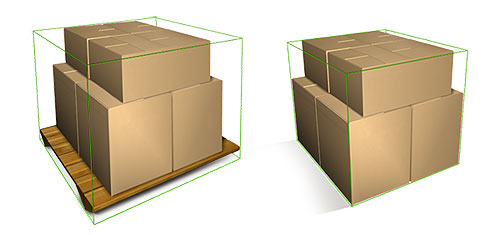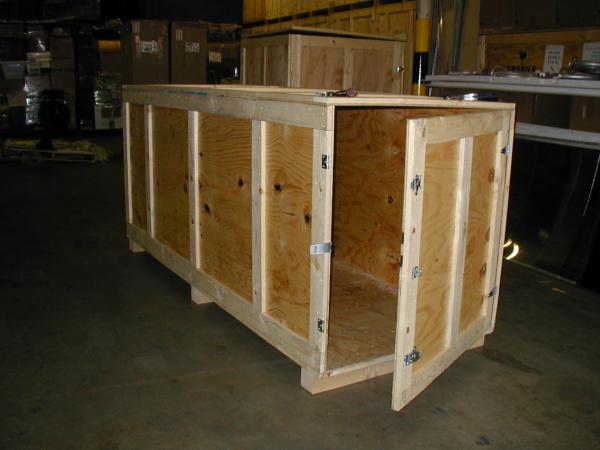Freight from the USA
|
|
|
|||
Palletizing in Sea freight | Chargeable (Gross) Volume | Guidelines | Shipping barrels | Shipping Crates
Palletizing cargo is a crucial practice in global logistics, enhancing efficiency and lowering international shipping costs. By securing goods on standardized pallets, international logistics companies optimize container space, expedite loading and unloading, and minimize damage during handling.
Pallets also simplify price calculations, as global freight rates for LCL shipments are based on volume (in cubic meters). Properly stacked pallets help maximize space usage, lowering transportation expenses. Additionally, palletized shipments are easier to track, transport, and store, ensuring smoother worldwide logistics.
Investing in quality palletizing ensures safer transit, faster deliveries, and affordable international shipping costs.
If you ship freight in boxes, bins, or smaller cases, your items will most likely be palletized regardless of transportation mode. Palletizing is mandatory in cargo transportation. Shippers can either palletize their loads themselves or request that a terminal palletize everything at the time of delivery for a fee if such a service is available.
On one hand, palletizing is essential for safe and damage-free cargo transportation. On the other hand, if a terminal palletizes everything, it adds a palletizing fee and increases the chargeable volume of your load. If you are new to global cargo transportation, we highly recommend reading this webpage to avoid confusion about palletizing for transportation from the USA.
If you ship a few cartons weighing less than 75 lbs, they may be shipped loose. When conveying goods in boxes, we recommend using heavy-duty cardboard moving boxes for added protection. Shipping boxes overseas has advantages and disadvantages.
ADVANTAGE: Sending abroad a few cartons weighing less than 75 lbs and not exceeding 72" in length should not incur additional freight costs. The total sea freight cost will be calculated by combining the volume of each box.
DISADVANTAGE: Shipping goods overseas in multiple boxes separately is unreliable.
If you ship items heavier than 75 lbs that are not accessible to forklifts, they must be placed on a pallet for handling.
If you ship smaller items loose, each one will be handled by hand at all stages of international shipping. There is no guarantee that the items will be appropriately handled during the conveyance from the USA.
IMPORTANT TO UNDERSTAND AND REMEMBER: If your intl shipment contains up to 3-5 small items, you may ask to ship it loose. However, IF YOU SHIP MORE THAN 3-5 UNITS OR THE WEIGHT OF A SINGLE BOX/UNIT EXCEEDS 75 LBS, THEN THE OCEAN CARRIERS' TERMINALS (CFS) WILL REJECT TO SHIP IT LOOSE. THEY WILL PALLETIZE EVERYTHING, REGARDLESS OF WHETHER YOU REQUEST OR NOT TO PALLETIZE YOUR LOAD.
The dimensions of the standard U.S. pallet used in international cargo transportation from the USA are 48 x 40 x 6 inches (or 1.2 x 1.0 x 0.15 meters). If smaller units are stacked on a pallet and wrapped with plastic film, it is referred to as a "pallet" or "skid."
Although standard-sized pallets are most commonly used in global cargo transportation, various pallets of different sizes and forms are also available. Pallets must be strong enough to hold the load, accessible for forklifts, and fit into 40-foot sea containers. Items exceeding 72" are considered oversized and subject to surcharges.
If you request an ocean carrier's terminal (CFS) to palletize your intl shipment, the CFS will appropriately stack everything on certified ISPM15 pallets and shrink-wrap it. Each pallet will carry as many smaller items as possible for safe handling by forklifts.
If you palletize on your own, then follow these rules:
When palletizing things for conveyance from the U.S. overseas, always pay attention to wood packing restrictions that apply in international cargo transportation.
ADVANTAGES: There are many benefits to palletizing and shrink-wrapping everything. Compared to non-palletized loads, palletized loads have a significantly higher probability of reaching their destinations without damage or loss. Forklifts will safely handle palletized cargo. Being palletized, all items are securely kept together, so the probability of a partial loss is insignificant. Palletizing protects from potential theft at any stage of transportation to the destination country.
As a U.S. Freight Forwarder, AMID Logistics highly recommends palletizing smaller articles for transportation from the U.S. to overseas destinations.
DISADVANTAGES: Additional charges apply. Please note that the international shipping cost estimated using our online freight calculator does not include the charges unless you ship overseas loads on appropriate pallets or forkliftable crates. It will apply to the carrier's intl freight cost and relates to:
IMPORTANT! Some terminals may not offer palletizing services or may limit the number of items that can be palletized. If you ship too many items, say 30+, you must consider self-palletizing your cargo before or when it is delivered to the terminal. Feel free to ask the terminal if they provide certified pallets and shrink-wrap film. If they do and you can do the job, plan for extra time to palletize everything at the terminal.

For example, a skid with dimensions of 40 x 48 x 60 inches equals a volume of 1.89 gross cubic meters (or 67 gross cubic feet).
People ask: How much does it cost to palletize my boxes? How can I estimate it?
The answer is: A CFS should properly palletize and shrink-wrap your boxes for $35-75 per pallet. The fee depends on the CFS. The price includes the cost of a certified pallet provided by CFS. Remember that if you palletize many things, the CFS may charge you for the labor per hour.
For example, you ship 20 Walmart large boxes, measuring 22 x 18 x 18 inches, and 10 Walmart medium boxes, measuring 17 x 16 x 16 inches. Using our online freight calculator, you've calculated the total volume of cargo that ships at 3.15 cubic meters.

Then, after palletizing, the rough estimate is 3.15 CBM × 1.25 = 3.94 CBM.
3.94 CBM: 2 CBM per pallet ~ 2 pallets. I.e., most likely, it should fit into two pallets.
IMPORTANT! If you requested palletization of your load at CFS but, at the time of delivery, the CFS cargo recipient claims to be unaware of the palletization, please do not worry. Most likely, the employee has not yet received a work order to palletize your intl shipment.
Do not argue. Just submit everything loose. Ensure the employee writes the number of units submitted on a copy of your dock receipt, dates it, and signs it. Keep the copy as proof of the delivery (POD).
Upon receipt of a warehouse receipt from the CFS, we'll reconfirm the palletizing work order. Your goods will be palletized appropriately, and we will notify you of this in our update email.
Guidelines on palletizing in shipping freight LCL
Before purchasing boxes, consider how they will fit into a skid(s).
Your boxes will most likely be stacked on a U.S. standard pallet(s) with a base of 40 x 48 inches (~1 x 1.2 meters). If possible, always purchase boxes of the same size and as many as they fill the rows of boxes on the pallet(s).
If you do not (or cannot) follow this rule, then it may result in a sharp increase in the "dead volume." Below are pictures that show how the chargeable volume almost doubled, comparable to the "net" volume of boxes, due to the improper set of boxes chosen for global transportation. The sizes of the boxes are different:
Below are boxes of the same size, but they do not fill the second row:
Ocean freight terminals strive to make skids as compact as possible. Below is a sampling of how mixed sizes of boxes and bins can be palletized by decreasing the "dead volume" to the minimum:
In the pictures below, you can see how perfectly boxes fit into skids if you follow the rule above. Professional exporters know that, and the "dead volume" for such shipmates is minimized and virtually does not impact the cost of international cargo transportation:
Here are the helpful hints if you self-palletize and deliver to a CFS entire skid(s):
Occasionally, people want to ship goods in barrels. For some reason, barrels are commonly used to ship from the USA to the Caribbean and Latin America.
Yes, you can ship goods overseas in barrels. However, we highly recommend packing your goods in heavy-duty cardboard boxes. You can purchase them at Walmart, Home Depot, or other retailers, or order them online. They cost about the same as regular cardboard boxes.
Please note that, in addition to the challenges of handling heavy barrels, the barrels will be palletized and shrink-wrapped for international shipping. Then, a dead volume will occur due to palletizing, especially if you send overseas several barrels that are not a multiple of four to fit in a U.S. standard pallet with the base 40"X48" (1X1.2 in meters).


Crating goods for global transportation can be quite expensive. However, in certain circumstances, it is necessary.

Crating is necessary if you ship valuable or fragile goods, such as assembled furniture, large but fragile items, or certain irregular and fragile items that require extra protection during transportation from the USA overseas. Regular or custom-made solid crates can be purchased from packing companies or ordered online.
You may also hire a professional packing company to crate your goods for international shipping from the U.S. As a U.S. Freight Forwarder, we'd suggest you ask a suck packing company if they are familiar with regulations in international cargo transportation, particularly with wood packing restrictions.
Note that crates, like pallets, must be forkliftable and fit into 40' multimodal sea containers.

Suppose a custom-made crate exceeds 48" in width. In that case, it will most likely not be accessible by a regular forklift and unsuitable for international shipping LCL.

Depending on the circumstances, it may be beneficial to ship in separate packing units. That means you can palletize and shrink-wrap smaller items, crate most valuable or fragile items, and leave oversized items loose. This approach can give you peace of mind about the safety of your shipped goods and save gross chargeable volume in your international shipping from the USA.
AMID Logistics operates as a U.S. freight forwarder, an international shipping company that coordinates bookings, ocean transportation, and documentation on behalf of shippers. Selecting the right freight forwarder helps avoid mistakes, ensures proper load handling, and facilitates affordable international shipping costs in global logistics.
|
|